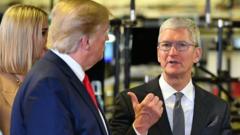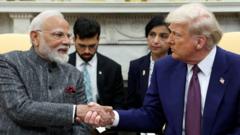In a bid to promote stability, the US and China have extended their temporary trade truce for 90 more days, keeping tariffs unchanged ahead of critical negotiations aimed at addressing trade imbalances and practices.
US and China Forge Temporary Trade Agreement, Dodging Tariff Hike

US and China Forge Temporary Trade Agreement, Dodging Tariff Hike
The US and China prolong their trade ceasefire for another 90 days, averting potential tariff increases that could have intensified economic tensions.
Article:
The United States and China have successfully extended their trade truce, avoiding imminent tariff hikes that could have escalated tensions between the two largest economies in the world. Just hours before planned tariff increases were set to take effect, US President Donald Trump issued an executive order maintaining the trade pause until November 10. The agreement was mirrored by a statement from Beijing, which reinforced its commitment to the truce.
As a result of this extension, the US will continue to impose a 30% tariff on Chinese imports, while China will maintain a 10% tariff on American goods. This decision comes after the US had earlier threatened to impose tariffs that could rise as high as 145% on Chinese products, which resulted in reciprocal retaliatory measures from Beijing that included 125% tariffs on US imports. The current tariff rates were reduced following trade negotiations in Geneva earlier this year.
The extension of the truce is intended to provide additional time for both nations to engage in negotiations aimed at correcting trade imbalances and addressing what the US labels as unfair trade practices. The White House highlighted a significant trade deficit of nearly $300 billion with China, indicating it as the largest deficit with any trading partner. As part of the discussion, both nations will work toward improving access for US exports to China and addressing national security issues relevant to the trade landscape.
A Chinese embassy spokesperson reiterated the importance of win-win cooperation, advising against the approach of suppression and containment, which they believe would be counterproductive. Furthermore, China has urged the US to lift what it terms as unreasonable trade restrictions and to foster a collaborative environment beneficial to businesses on both sides, particularly in the semiconductor sector.
The uncertainty surrounding tariffs continues to concern American business owners, with some expressing that the situation leaves little room for concrete planning. As trade negotiations remain volatile, tensions have heightened since April, when tariffs from Trump covered goods from multiple countries, impacting Chinese goods significantly. The resulting backlash has led to a series of tariff escalations, creating a precarious trade environment.
Currently, discussions persist regarding several contentious issues such as China's acquisition of rare earth materials, its imports of Russian oil, and US limitations on the sale of advanced technologies, particularly semiconductors. Recently, the Trump administration partially relaxed some export restrictions, allowing companies like AMD and Nvidia to sell certain chips to China under specific conditions.
Despite the temporary relief, trade activities between the two nations have remained sluggish, with the US Department of Commerce reporting a nearly 50% drop in imports of Chinese goods in June compared to the previous year. Similarly, American exports to China saw a decline close to 20% over the same timeframe. As both sides work towards resolving these intricate trade issues, the continuation of the truce offers a momentary reprieve in the ongoing economic battle.
The United States and China have successfully extended their trade truce, avoiding imminent tariff hikes that could have escalated tensions between the two largest economies in the world. Just hours before planned tariff increases were set to take effect, US President Donald Trump issued an executive order maintaining the trade pause until November 10. The agreement was mirrored by a statement from Beijing, which reinforced its commitment to the truce.
As a result of this extension, the US will continue to impose a 30% tariff on Chinese imports, while China will maintain a 10% tariff on American goods. This decision comes after the US had earlier threatened to impose tariffs that could rise as high as 145% on Chinese products, which resulted in reciprocal retaliatory measures from Beijing that included 125% tariffs on US imports. The current tariff rates were reduced following trade negotiations in Geneva earlier this year.
The extension of the truce is intended to provide additional time for both nations to engage in negotiations aimed at correcting trade imbalances and addressing what the US labels as unfair trade practices. The White House highlighted a significant trade deficit of nearly $300 billion with China, indicating it as the largest deficit with any trading partner. As part of the discussion, both nations will work toward improving access for US exports to China and addressing national security issues relevant to the trade landscape.
A Chinese embassy spokesperson reiterated the importance of win-win cooperation, advising against the approach of suppression and containment, which they believe would be counterproductive. Furthermore, China has urged the US to lift what it terms as unreasonable trade restrictions and to foster a collaborative environment beneficial to businesses on both sides, particularly in the semiconductor sector.
The uncertainty surrounding tariffs continues to concern American business owners, with some expressing that the situation leaves little room for concrete planning. As trade negotiations remain volatile, tensions have heightened since April, when tariffs from Trump covered goods from multiple countries, impacting Chinese goods significantly. The resulting backlash has led to a series of tariff escalations, creating a precarious trade environment.
Currently, discussions persist regarding several contentious issues such as China's acquisition of rare earth materials, its imports of Russian oil, and US limitations on the sale of advanced technologies, particularly semiconductors. Recently, the Trump administration partially relaxed some export restrictions, allowing companies like AMD and Nvidia to sell certain chips to China under specific conditions.
Despite the temporary relief, trade activities between the two nations have remained sluggish, with the US Department of Commerce reporting a nearly 50% drop in imports of Chinese goods in June compared to the previous year. Similarly, American exports to China saw a decline close to 20% over the same timeframe. As both sides work towards resolving these intricate trade issues, the continuation of the truce offers a momentary reprieve in the ongoing economic battle.



















